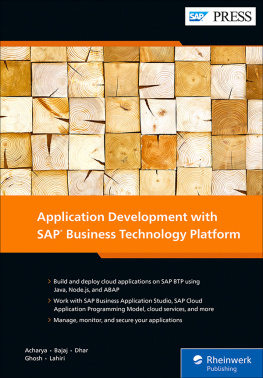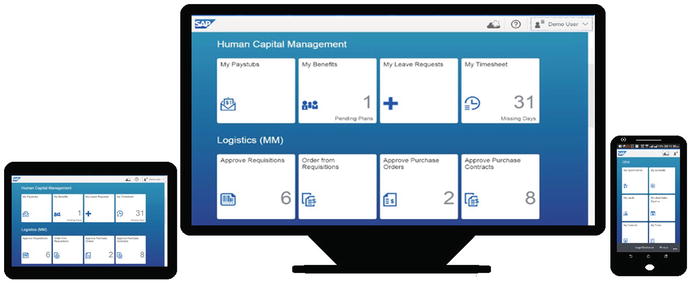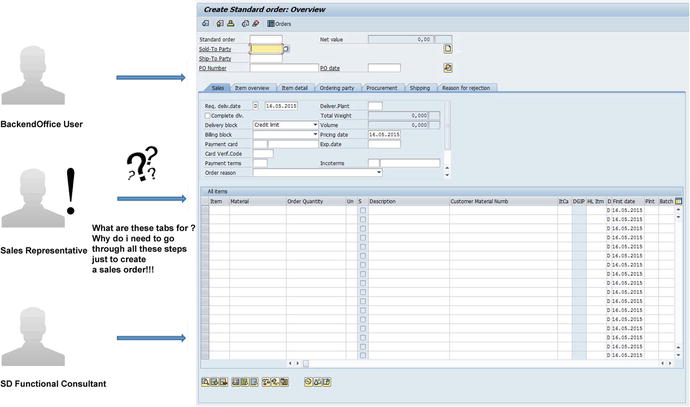SAP Fiori is a new offering from SAP, based on the HTML5 framework. A great deal of help regarding Fiori is available on the Internet, but the information is scattered across many web sites and sources. Users who are new to SAP Fiori may find it difficult to get an overall idea of what Fiori is. This book provides an overview and gives you the knowledge you need to configure, implement, and extend Fiori applications.
This chapter covers the history of SAP Fiori and examines SAPs roadmap to a unified user experience (UX) for all of its products.
Why Fiori?
In the past, SAP customers complained about the old-fashioned look and feel of the standard screen and the fact that SAP can only be accessed via its desktop GUI for most transactions. SAP listened to this feedback from all over the world and launched a set of applications, based on the HTML5 framework, that includes the most widely and frequently used SAP transactions: purchase order approval, sales order creation, information lookup, self-service tasks, and so on. These HTML5 applications are easy to access seamlessly across desktops, tablets, and smartphones (see Figure ). This collections of apps is named Fiori.
Figure 1-1.
The Fiori user experience as seen on all types of devices
The term Fiori is an Italian word that means flowers. SAP wanted a beautiful UI for its current GUI, and it also wanted to create a simple, elegant user experience. Initially, SAP charged a license fee per Fiori user. After receiving complaints from customers about paying for an additional license on top of their existing ERP license, and from service companies who found it difficult to convince customers to pay the additional cost, SAP announced at the February 2014 SAPPHIRE event that Fiori would be free for any customer with an SAP license. This decision resulted in a higher adoption rate for Fiori and increased market demand for Fiori-based custom UI5 applications.
One drawback of current SAP transactions is that some transactions are complex, and the same transactions are used to perform multiple tasks. As a result, transactions may have many fields and configurations and become difficult to use. For example, suppose a sales and distribution (SD) consultant accesses transaction VA01 to perform SD-related tasks (see Figure ). The transaction works fine if the user is familiar with the complex steps and fields required to complete the task. But a sales representative whose priority is making sales rather than spending time creating a sales order in the complex GUI, this transaction may be difficult, and many of the fields and options may seem confusing and irrelevant.
Figure 1-2.
An example scenario with the VA01 Create Sales Order transaction
To avoid such cases, SAP simplified its complex UIs and split them into multiple simple UIs whose elements make sense to the user. For example, when a sales representative uses the Fiori Sales Order application shown in Figure , all the elements are useful. The sales rep can create sales orders without using the SAP GUIthe rep can even create a sales order on the go, from a mobile phone.
Figure 1-3.
The Fiori Sales Order application simplifies the VA01 transaction by including only the minimum required fields to complete the task
In addition, to perform simple operations, SAP users sometimes have to execute multiple transactions. SAP split these complex transactions into smaller apps, simplifying them and making them specific to the roles of particular users. At the same time, SAP merged repetitive transactions. Using this approach, SAP created role-based applications: the first wave of Fiori applications (known as Fiori Wave 1 apps) consisted of a set of 25 applications targeted at users such as managers, employees, sales representatives, and purchasing agents.
Introduction to the SAP UX Strategy and the SAP Fiori UX
The new UX for SAP simplifies the old GUI and makes it compatible with any device of any screen size that supports HTML5, including mobile devices. This change was a big step for SAPit adopted an entirely new technology and strategy for its UI.
SAP UX Strategy
Enterprise resource planning (ERP) software was developed to provide increased functionality. Although ERP solutions have powerful features, end users sometimes find the UI complex and even intimidating. Most of the time, users dont use ERP software based on its features and its ability to handle complicated tasks; they give priority to UI ease of use and the ability to complete their required tasks with the least amount of effort.
For example, consider Facebook. A user may find it easy to use the Facebook web site when they have access to a desktop or laptop. But when the user is on the move, accessing the same fully featured web site via a mobile device can be complex and frustrating. Using the Facebook mobile app gives the user a simpler UI and easier layout to update their status, check notifications, see what their friends are up to, and so on. The most powerful and sophisticated UI is not always the best answer for providing users with a good UX. For this reason, SAP put its users first and developed an intuitive, consistent, simple UX. It saves users time and increases their productivity. The UX provides benefits like these:
To achieve the goal of providing this enhanced UX, SAP has three primary areas of focus:
New : Its all about providing consumer-grade user experiences for new applications.
Renew : SAP provides an improved UX for its existing applications. As a start, SAP based the Fiori apps on some of the most commonly used SAP applications.
Enable : SAP helps its partners and customers improve the UX of other existing SAP software.
Initially, SAP developed Fiori apps with the Renew strategy in mind by creating a new UX for the existing and most commonly used business scenarios in SAP software. But later, this approach evolved into a new standard UX strategy for all SAP software. With the release of S/4HANA, SAP is moving closer to its goal of one UX for all SAP solutions.
SAP Fiori UX
The SAP Fiori UX is the new face of SAP for its business users across devices, platforms, and deployment options. It provides optimal usability and simple business interactions and ease of use. Fiori is not just a new UI or a new theme on top of existing SAP transactions; its a new concept of providing user-centric applications.
A traditional SAP transaction generally has numerous screens, fields, and tabs that encompass multiple features and types of functionality and can serve multiple users. These transactions end up with many fields, navigations, and features that dont apply to all usersrather, each part, tab, or area of the transaction is targeted at a different type of user (see Figure ).




















